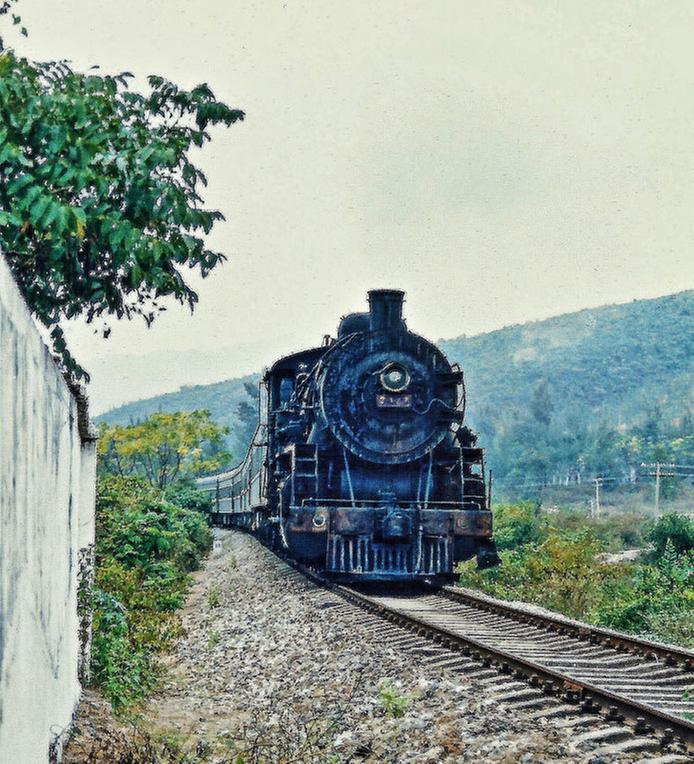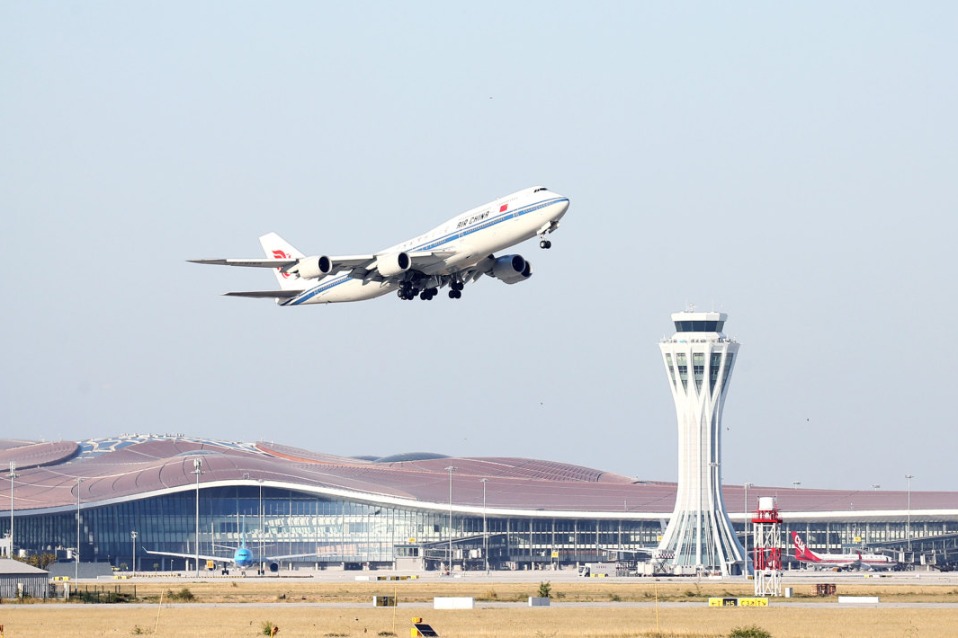Traveling on board China's trains for 30 years

|

|
| Local train passing Tianya Haijio Sanya Hainan 1993. [Photo by Bruce Connolly/chinadaily.com.cn] |
Coming up from Tianjin to Beijing on train mid-August, the onboard display read 304 kilometers per hour. Exactly nine years ago, China’s first successful high-speed rail service started between the two cities, covering the 117 km in only 30 minutes - the world’s fastest conventional train. In an ear-lier attempt at high-speed rail travel, the China Star ran between Shenyang and Qinghuangdao in 2005 but was limited to 160 km/hr. By 2016, China’s high-speed network had stretched over 22,000 km with a goal to reach 30,000 km by 2020. China’s total rail network is more than 121,000 km and expanding annually.
Relaxing in comfort, my mind drifted back to 1987 when I started traversing China’s rails - a very different experience. From Beijing it was two nights on a non-air conditioned 18-coach green train south to Guangzhou along the main north-south rail corridor.Virtually everything went up and down that key line - there were no expressways, roads were for local use, while aviation was tiny compared with today. But that train revealed a very beautiful China, a landscape I had previously never appreciated. It was an opportunity to meet people, to share time and food while being woken at sunrise by fellow passengers as we approached Zhengzhou and told “Look, we are crossing the Yellow River!”
The journey introduced some of China’s early railway engineering achievements particularly the Wuhan Yangtze River Bridge that opened in 1957. In 1996, I would walk across another great Yangtze bridge at Nanjing completed in1968. The line south from Beijing to Wuhan started opera-tion in 1906 and was extended to Guangzhou in 1938. Before the bridge opened, railway cars had to be ferried across the Yangtze. The line passed through the mountains of Hunan and northern Guangdong to Guangzhou via lengthy tunnels and viaducts. Something I soon realized was that China’s railways mostly go in straight lines - if there is a mountain, tunnel through,don't go round it! One of the few air-con soft seat trains in China at that time, carried passengers along the former KCR (Kowloon Canton Railway) onwards to Hong Kong. Soon high-speed trains will directly con-nect Beijing with Hong Kong in about 10 hours.
Since 1987, China’s railways have undergone a transformation almost hard to comprehend and amazing to personally witness.
For a country the size of China with so much geographical diversity, rail has long been the only feasible and safe option for nationwide connectivity along with the ability to efficiently move so many people at critical periods such as Spring Festival.
Despite the length of today’s network, China was a relative latecomer to rail. The Qing court initial-ly regarded steam engines as "clever but useless contraptions" introduced by foreigners and quickly dismantled. The 14.5 km Woosong-Shanghai Railway, financed by British businessmen opened in 1876 and closed 16 months later. In 1881, a 12 km long line carried coal from Tangshan to Xugez-huang, an interchange point for canal and river connections to Tianjin and Beijing.
Over the years, it has been fascinating to travel along lines associated with China’s railway devel-opment, lines that ultimately helped build the China we know today.
In 1999, I boarded the narrow-gauge railway from Kunming to Hekou - a Red River (Honghe) crossing point to Vietnam - built by the French in 1910 partly to extract tin from Gejiu in Yunnan, but also to draw the area more into Francophile IndoChina. Closing for passenger services in 2005, it continues to carry freight. A standard-gauge railway now links Hekou with Kunming and Dali.
Lines in Dongbei reveal a long historic connection with Russia and connections into the Trans-Siberian system. Dalian’s Lushun district, at the southern end of a spur from the former Chinese Eastern Railway, still has an ornate Russian station.
By 1911, China, despite its vast size, had only about9000 km of rail lines including the renown Bei-jing to Zhangjiakou Railway engineered in 1908 by Zhan Tianyou across the Badaling Pass. Ex-tended to Baotou in Inner Mongolia, that line effectively ended camel transport into Beijing, con-necting the capital directly with Silk Road trade.
Distinguished leaders such as Dr Sun Yat-sen saw rail transport as the way forward for Chi-na.Indeed, railways have long been regarded as essential for national growth, stability and connec-tivity. However for half a century the country’s development was held back by war and internal conflict. By 1951, the usable network was only about 22,000 kilometres and almost totally relying on steam traction. But the period of railway development was about to start with some incredible engineering achievements pushing railways through very difficult terrain to unite the southwest and northwest of the country with the eastern seaboard. Partly by relocating strategic industries to prov-inces such as Sichuan, railways were constructed which, even today, stand out as amazing engineer-ing achievements.Lines that I have traveled along and been enthralled at their construction through seemingly impossible terrain.
In December 1949, Deng Xiaoping, then Secretary of the Southwest Bureau, proposed construction of a railway between Chengdu and Chongqing. Completed in 1952, it was the first built after thees-tablishment of the People's Republic of China. Electrified in 1987, the line was transporting 90 mil-lion tons of cargo and 70 million people annually by 2008. In April 2017, a high-speed train carried me in under two hours between both cities. I was in Chengdu to undertake a journey along a line that stands out in the history of modern China, a line I had first experienced in 1994. Train T8 de-parts Chengdu at 9 am arriving almost 28 hours later in Beijing. During daylight hours it travels north through the attractive mountainous landscapes of Sichuan, eastern Gansu and southern Shaanxi. The line was originally proposed under Sun Yat-sen’s 1913 China National Railway Plan to link up Datong with Chengdu. Opened in 1958, the Baoji-Fengzhou section was electrified in 1961 - China’s first railway electrification. Sections of the Baocheng Line were badly damaged dur-ing the 2008 Sichuan earthquake. Later this year, the Xi’an-Chengdu High-Speed Railway will open - another engineering milestone.
Chengdu was the start of another amazing feat of railway engineering - the Chengkun line to Yun-nan’s capital, Kunming. Built between 1958 and 1970 it travels 1,134 km through very rugged ter-rain via a complex mixture of tunnels connected by short viaducts. Many travelers used this line as a way of reaching Lijiang in Yunnan by bus from Panzhihua.Today, Lijiang is directly served by train from Kunming. Indeed, every journey into Yunnan involves spectacular rail travel. In 1995, my first venture to that southwestern province was 47 hours from Beijing going through Hunan, Guizhou and Yunnan along a railway that at times literally clung to cliffs above deep valleys - many ethnic people farmed the slopes alongside the tracks.The train was a spellbinding way to see and appreciate such remote, such stunning and such fascinating landscapes. Today ,travelers in a hurry can zoom between Shanghai and Kunming in under 11 hours on the ‘gaotie’ but for me the slower conventional trains allow more time to absorb the passing scene and to get off at platforms where food carts provide additional sustenance for rail travelers.
The Hexi Corridor, carrying the fabled Silk Road between Gansu and far western Xinjiang, has for centuries been an essential line of connectivity to Central Asia. Construction between 1952-62 led to a railway pushing through some of the most inhospitable and least populated terrain in China in-itially to Xinjiang’s Urumqi.It now connects via Kazakhstan to Europe. That railway carried me westwards beyond the Great Fort at Jiayuguan onwards to the Lake of Heaven - a journey featured on Scottish radio travel programs. A journey that earlier in Ningxia showed another of China’s pio-neering railway achievements - taming the desert sands at Shapatou to allow rail tracks to skirt round the Yellow River and on to Lanzhou.It was something sceptics said was impossible but just like the railway to Lhasa and the development of a high-speed network has shown, China leads the world in railway construction and development.









































